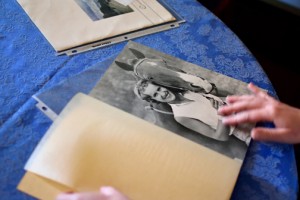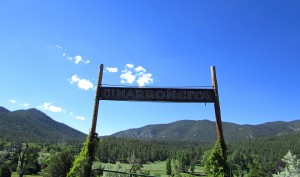Almost anyone who spent part of a summer childhood at camp remembers it with sweet nostalgia—canoeing, shooting arrows, making crafts, and singing around a campfire. Such visions have filled our curatorial heads since November 2014, when Alán Huerta and Minnette Burges approached the museum to gauge our interest in acquiring the contents of their Cimarroncita Ranch Camp for Girls. The couple needed to clear out an archive documenting camp life from 1930–1995—not to mention a lifetime of memories.
“Anytime you acquire a large collection that’s tied to family history, there are opportunities to have many conversations,” said Meredith Davidson, curator of 19th– and 20th-century Southwest collections. “In this instance, the history of the summer camp extends to the 1930s, so there are several generations interpreting the camp’s daily activities and the people who went there.”
 In mid-May and again in mid-June, a team of History Museum staffers bundled into vans and trucks and headed northeast to the one-square-mile camp for the latest round of conversations and acquisitions. Eventually, they drove away with materials from the camp’s 60-plus buildings, including approximately 150 reels of 8mm and 16mm films from the ’30s and ’40s, sports equipment, scrapbooks, saddles, furniture, books, trunks, a horse-drawn sleigh, and a 400-pound copy press that once belonged to the Atchison, Topeka & Santa Fe Railway.
In mid-May and again in mid-June, a team of History Museum staffers bundled into vans and trucks and headed northeast to the one-square-mile camp for the latest round of conversations and acquisitions. Eventually, they drove away with materials from the camp’s 60-plus buildings, including approximately 150 reels of 8mm and 16mm films from the ’30s and ’40s, sports equipment, scrapbooks, saddles, furniture, books, trunks, a horse-drawn sleigh, and a 400-pound copy press that once belonged to the Atchison, Topeka & Santa Fe Railway.
The camp is being sold to the neighboring Philmont Scout Ranch, which added some urgency to the task. The team included Director Andrew Wulf, curators Davidson and Daniel Kosharek, Photo Archivist Emily Brock, Librarian Tomas Jaehn, Digitization Specialist and Photographer Hannah Abelbeck, Registrar Deborah King, Collections Manager Yasmin Hilloowala, Exhibition Designer Caroline Lajoie, Preparator Doug Jewell, and Operations Manager Seth McFarland.
 Part of their time was devoted to conversations with Burges and Huerta to narrow the group’s focus—and to assure the couple about how their collection would be treated.
Part of their time was devoted to conversations with Burges and Huerta to narrow the group’s focus—and to assure the couple about how their collection would be treated.
“When a donor chooses to have a collection come to a museum, it’s the beginning of a relationship,” Davidson said. “They need to sure that their materials will be kept for perpetuity and made accessible to them and other people.”
Already Brock has received calls from former campers curious to see the photographs. Davidson and Kosharek imagine the materials someday leading to a nostalgia-themed exhibit tying us to a new group of visitors: former campmates.
“In a dream world,” Davidson said, “this collection could provide the basis for a larger project on summer camps in New Mexico and the experience of growing up in the West.”

